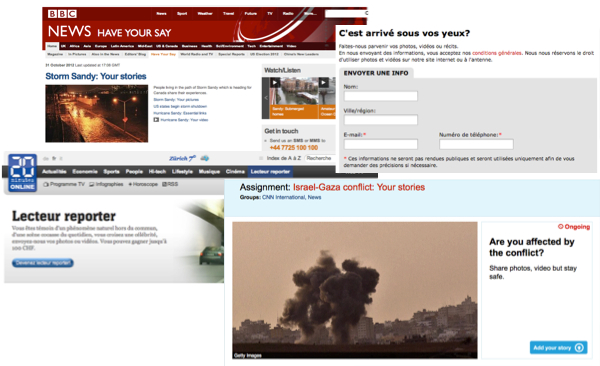Posts Tagged CNN
Crowdsourcing: how is this concept applied to journalism?
Posted by celinebilardo in Technology on November 27, 2012
With the rise of the Web 2.0, more and more people get to express themselves on the Internet: by contributing to a personal blog, answering to a poll on a website or making comments on any event the web is talking about. Today, those contributions can be neatly managed by news organisations to make you participate to their news production. And this is the object of this blog’s entry: crowdsourcing the news.
The crowd likes to be involved
Jeff Howe is the man who coined the term “crowdsourcing” in 2006 in an article called “The Rise of crowdsourcing.” At the time he was a contributing editor of the Wired magazine. Now he tends to be perceived as The Crowdsourcing expert. But you may wonder…
What is crowdsourcing?
As Jeff Howe well expressed it, crowdsourcing is a process of involving the public, the crowd, into a task by an open call. And this process if often made through a website. The definition could include many sorts of calls, indeed. To a large extent, crowdsourcing can be applied to solving a scientific problem, as the company InnoCentive started to do in 2001, or as IStockphotos managed in outsourcing the task of photographing an event to a voluntary crowd instead of hiring a professional photographer for instance.
Crowdsourcing takes many forms. But one thing makes it unique: it empowers the crowd. As the crowd represents different brains, different competences, it can be even more creative, efficient, innovative and influent than a single man working in his office on a task he has no grasp into.
How news organisations make the most of it?
In the context of Journalism, you can well imagine that the journalist and the news organisation one can work for were primarily the only gatekeepers of news, and you were waiting for them to be informed. If there was a place for you to communicate with the newspaper, there was the “letters to the editor”, and not many more.
Today news organisations have their websites. Moreover, if you give a closer look to them, you will notice they even make a space for you to act and communicate. Not by solely adding comments. There is more!
In England, the BBC has launched Have your Say ; in the USA, CNN opened iReport. And the Swiss news organisations are not the last: The RTS has Vos infos and The 20minutes has the Lecteur-Reporter’s platform. All fell in the new trend. They all let you the chance to be part of their work, or in other words: now the news need you.
As a million of events happen across the world, reporters and journalists cannot cover them all. This is where the audience is powerful: it can improve their coverage.
When terrorists set off a series of bombs on buses and subways in London, who produced the most riveting images and sound bites? The passengers and their cell phones.” [1] When an accident occur next to your home, or on your way to work, you are the first witness of the event and no professional reporter could catch the same tension you were able to grasp when it happens.
With a single photo, a video, a short message, you can make a newsroom get up. You can even make it change its editorial agenda.
For Bernard Rappaz, Editor in chief at the RTS in Switzerland, crowdsourcing makes a news media quicker than before. Using Twitter, Facebook, and their crowdsourcing tool on their website, the members of the newsroom can compete with the news agencies they are sometimes dependent on. As Mathieu Coutaz confirms himself: it allows the staff to be the first on the scene and to be always closer to the stories that interest the people their work for.
Mathieu Coutaz is the content manager for 20minutes online in the French-speaking part of Switzerland. The 20minutes is The daily newspaper distributed in Switzerland and this, for free. Its platform “lecteur-reporteur” has been launched in 2006 and the newspaper rewards any contributions that it eventually publishes on its web. What is most, “50% to 70% of the contributions that are selected go on the print edition” Mathieu Coutaz explains. And he emphasises one fundamental point that cannot be neglected: your photos and stories go through a process of verification before getting anything done. “When verified, the contributions of the audience can influence the editorial agenda on the temporal and hierarchical aspects. If it has to be treated before another news, and if the story is worth being published at the top of our agenda, then of course we do it.”
For the one that may want to ask: But isn’t it citizen journalism? In fact, no it isn’t. Robert Niles states this argument in his “Journalist’s guide to crowdsourcing”:
Crowdsourcing does not ask readers to become anything more than what they’ve always been: eyewitness to their daily lives.
In that sense the news organisations save their first role of gatekeepers: the readers don’t write the stories, they only contribute to it: the final decision of its treatement and broadcast still lies in the professional’s hands.
Crowdsourcing at risks
In an interesting article, Darren Gilbert warns that “crowdsourcing can be as advantageous as it can be dangerous.” Although readers are willing to contribute to the news, some are able to get a journalist on the wrong track. He takes the example of a recent scandal that occurred in the United States: a company named Journatic published news gathered from the public. And there were actually wrong!
In Switzerland, all the news platforms I discovered ask for the name and mail address of the contributors, in order to be able to get back to him/her. A mail address can be fake, indeed, but in any case, Swiss news organsations do the verification before publishing, which can avoid some serious faux pas.
To cope it all, crowdsourcing may well bring the public and the news organisation closer than before. It may establish a new relationship between the public and the news media: a trust that could have been lost. But it still needs to be well used in order not to lose what crowdsourcing is for journalism: a relevant tool to make the crowd part of the work, for a better and substantial result.
I am now turning to you
Have you ever contributed to the news of your local newspaper?
What do you think of the crowdsourcing concept regarding journalism?
And to go further…
A new trend in crowdsourcing is for journalists to use special crowdsourcing platforms to gather the information they couldn’t find from their places, such as Ushahidi‘s platform, specialised in mapping crowdsourcing information.
The TED talks also got into the crowdsourcing concept, here is a talk held by Paul Lewis about the impact of crowdsourcing the news for investigative journalism.
And to be always up to date with the last seminars about crowdsourcing and journalism, have a look at the European Journalism Center’s website, it’s worth it!
By Céline Bilardo
[1] Howe, J. 2008. Crowdsourcing: Why the power of the crowd is driving the future of business. 1st ed. USA: Ed.Crown Business. p.212.
How and in what ways have social networks such as facebook changed the definition of private life?
Posted by pontus4 in Technology on January 10, 2011
Since its creation in 2004 by Mark Zuckerberg, facebook has had an ever increasing number of members. Originally set up as a college dating site, and a place where Mark Zuckerberg and his friends could “rate” girls faces according to their “hotness”, it quickly developed into a major social network site available to all. Nowadays, it seems that “everyone” is on facebook, (approximately 500 million members are registered today) and facebook is often the place where events amongst friends are organised, information related to parties but also work and university lectures in exchanged. But it is not only written information which is shared, pictures are also posted, with no limit as to the amount of photographs that a single user can post. Users can also post pictures of their friends, sometimes in not so flattering situations, and post whichever comments they want, about whomever they want, thinking that these will never be seen by the people concerned. But some people have discovered the pitfalls of facebook to their great despair.
In December 2008 in France, three people where fired from a company after criticising their superiors and the company itself on facebook. Their pages where open for viewing to “friends of friends”, which is how the management of the company eventually saw the degrading and condescending comments, Similar stories have happened in the past. In the UK, an employee posted a comment on her facebook wall on a Friday stating that she hated her job and her boss and that she did not look forward to returning to work on the Monday. Her boss saw this comment. His reply was quick and to the point “oh yeah? Well you won’t be coming back on Monday anyway, since you’re fired. Goodbye!”. Similarly, company owners have declined to give someone a job offer based on information or pictures they have seen on candidate’s facebook pages, if they believe that what they have seen there does not give an appropriate image of the person in question. This is the problem with many social network sites such as facebook, MySpace, Hi5 or similar. People do not realise that all images uploaded on facebook become the property of Google, and that once published on the internet, if their settings are not carefully privatised, these pictures can end up in places never before imagined, such as in the hands of a future employer for example.
Recently, it has been revealed that 92% of the babies under 2 years old in the USA are either on facebook or on other social networking sites pictured on photographs uploaded by their parents! In France, this number is only slightly less, with 73%. 33% of babies already have their photo published on the internet at the time of their birth! These statistics are of course alarming, and perhaps we are not that far away from pictures and videos of the actual births themselves being posted on facebook in minute detail, with people “liking” them and a few years later “tagging” themselves in the picture of them coming out of their mothers womb! People have even started posting scans of their foetuses on facebook.
Another quite extreme case was related by the Swedish newspaper Expressen during the summer of 2007. The article spoke about a woman who had divorced her husband, and, a few weeks later, had met another man, which she had immediately married. As a consequence, she changed her facebook status from “single” to “married”. When her ex husband saw this, he became furious, went over to her house and killed her. One may of course say that this man was perhaps unstable in many ways, and even if facebook had not been there to tell him the news, he would perhaps eventually have found out through another source, and will most likely have killed her anyway, but this example, and the others discussed above definitely prove that it is perhaps not that wise to put every single detail about your private life up on facebook and on social networking sites, as after all, any information you put on facebook, by the second it is up there, it in effect is no longer private, but becomes public information. Thieves may be able to plan hits on a wealthy person0s home because he sees on their facebook page that they are abroad for a month for example, and the statistics about a person0s private life, which are stored in the facebook database, can be transmitted to organisations such as the FBI or similar if they where to ask for it, as well as to advertisers, which, in some cases has happened in the past. Indeed, even if you delete the information from your profile, it is not permanently deleted from the databases. The website openbook.org enables you to search any facebook profiles which do not have strict privacy settings, and shows that even criminals if they wanted to, could potentially access private information of unsuspecting victims.
Nevertheless, if you are careful with the way in which you use social networking sites, they can be very useful planning and communication tools, and many big companies and TV channels such as CNN for example now also have their own facebook page, for conveniently sharing information with colleagues and the general public. So in conclusion, social networking sites have definitely changed the definitions of private life both in a positive and a negative sense, but if used wisely and carefully, they can prove to be very helpful tools of communication indeed.
Pontus Wallstén
AJM






